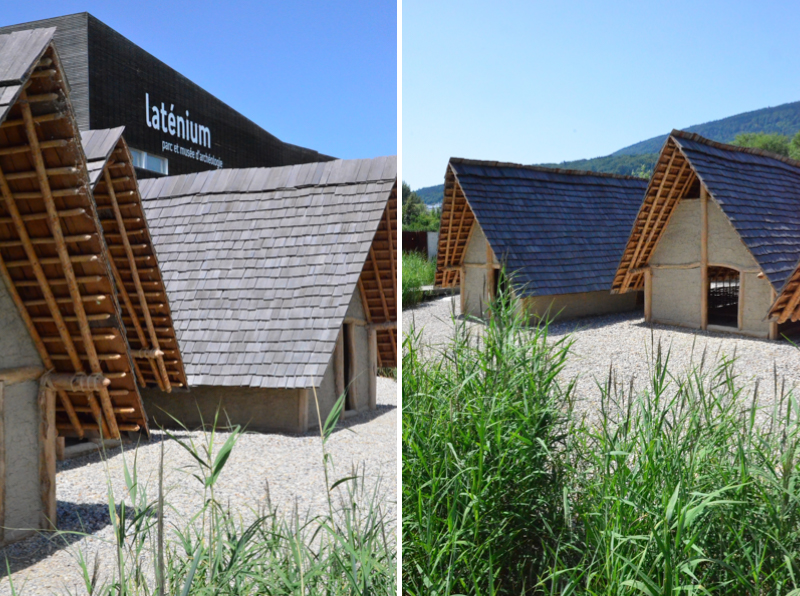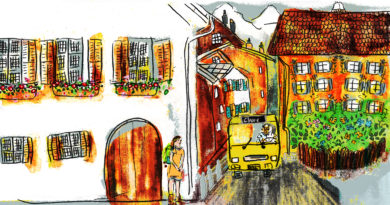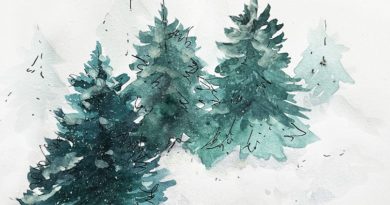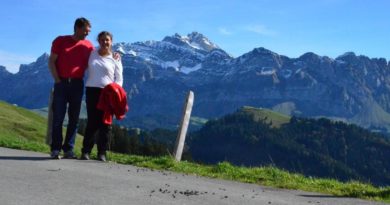Exploring Ancient Cultures along Alpine Lakes
Pile-dwelling and La Tène Cultures along Alpine Lakes in Neuchâtel, Switzerland and Unteruhldingen, Germany
Our trip to Augusta Raurica, the former Roman outpost on the RhineRiver, earlier this summer (“Roman Footsteps in Switzerland,” June 2016) whetted our appetites to learn more about past cultures that inhabited Switzerland and the surrounding alpine lands. So our family spent some time in June and July exploring more Gallo-Roman artifacts, Paleolithic hunter-gatherer sites and the famous settlement site of the La Tène Period Iron Age Culture at Laténium (from “La Tène”) on Lake Neuchâtel, in Neuchâtel, Switzerland as well as the remnants of the pile-dwelling (Pfahlbau) cultures of the Neolithic and Bronze Age cultures at the Pfahlbauten Museum on Lake Constance in Unteruhldingen, Germany.
It is no coincidence that both museums are located upon lakes. The pile dwellers (formerly known as lake dwellers) occupied 111 lake areas in six present-day European nations: Switzerland, Germany, Austria, Italy, France and Slovenia, with 56 sites located in Switzerland and 18 sites in Germany. In 2011 all of these sites were accepted into the UNESCO World Heritage list, as they represent an important period in the development of humanity. There are only a few locations for visitors to view these sites, because most are either underwater or buried deeply beneath sands. But the buried sites are so important! Such materials as wood, bone, and leather are beautifully preserved due to the lack of oxygen under these conditions. Sites like these thrill scientists, because they have the chance to recover barely-altered everyday objects that tell them how these early people lived.
Both museums house fascinating exhibits, informative videos (in German or French), some information in English, and tantalizing hands-on activities for young and old. We decided to visit Laténium first, because of its location and the range of human history covered. Laténium consists of a permanent exhibit, special exhibits and an archaeological park located outside of the museum building. Our children always enjoy this area, as there are different climates and environments represented and large reconstructions and genuine artifacts are displayed, such as a Bronze Age pile dwelling and a Roman barge. More important, however, is the mystery and significance of this area for humanity. Direct evidence of four past cultures have been discovered in the vicinity. The type section for the La Tène Celtic Iron Age culture (450 to 50 BC) was found in 1857 on the shores of LakeNeuchâtel – one of the most important sites for Celtic civilization. Recently, when the museum was being built and the local highway constructed, evidence of three other former communities was discovered: one from the Bronze Age (1056-871 BC), another one from the Neolithic (3810-3790 BC) as well as a much older a hunter-gatherer site dating back to around 13,000 BC. Of course the lake is still inhabited today, and it is breathtaking on a clear day, yet I am partial to this area on mornings when the lake is cloaked in mist.
The hunter-gatherer site previously mentioned was removed and can be observed, along with artifacts from the other periods, in the permanent exhibit of the museum. The permanent exhibit spans 50,000 years of human history. I was struck by the aesthetic nature of the museum building itself as well as the exhibits. Care has been taken to make the exhibits both scientifically correct and accessible to a spectrum of ages and educational levels. Young children and teens, mine included, can explore and play, read and view according to their interest and ability. As you enter the museum you are confronted by sculptures of humans of different species as well as from different historical eras, which makes human evolution personal and approachable. The visitor strolls through eight different rooms moving back in time from the Renaissance, Ancient Rome, the La Tène Celtic period, and finally the Paleolithic period. My sons have been to this museum three times already, and they still enjoy visiting it! There is so much information and so many play/learning activities that even adults can enjoy. For instance, you can recreate a Roman mosaic, learn to tie knots as a medieval ship builder did, view the likeness of a young Roman girl, or watch the life-or-death struggle between a Stone Age hunter and a bear, who met in a cave located in the Jura Mountains.

All in all we spent about three hours in the museum and park, so I think you should plan at least two hours for the visit. It is possible to book a tour, and children can attend a workshop (in French) to make cave paintings or craft a mammoth tooth. The museum has a gift area with the usual assortment of books and replica artifacts, as well as a café. You can also picnic in the vicinity or travel into Neuchâtel for the rest of the day as we did.
Opening Hours: Tuesday through Sunday from 10:00-17:00.
Admission: adults SFr.9, students SFr.5, children (ages 7-16) SFr.4.
Travel information: latenium.ch/en/pratical-information/
Further general information on the Laténium website
The Pfahlbauten museum (pile-dwelling museum) consists of two museum buildings and a reconstructed settlement of 16 buildings on pilings, which depicts the life of farmers, fishermen, and tradesmen, as well as women who would weave, forage and prepare food and care for children from different periods ranging from 4,000 to 850 BC.
When we arrived, we were ushered into a room with a 360-degree panorama film, Archaeorama, about underwater pile artifacts and how archaeologists diving in LakeConstance excavate and study the site. Our youngest son particularly enjoyed reading about and seeing the actual artifacts that have been excavated at this and other sites over the past 150 years. Because the artifacts are found underwater, archaeologists believed until recently that the people lived in dwellings perched over the lake, hence the common name for these people – lake dwellers. Today archaeologists think that originally the dwellings were built on the edge of the lakes or in marshy regions on piles to protect the inhabitants from flooding and perhaps attacks. And that the artifacts are currently underwater because the water level of the alpine lakes has changed over time, inundating the originally marshy region with lake water and leaving the remains of the settlements under water. It is amazing that more than 50 former settlements have been discovered to date in Switzerland, the first being in LakeZurich.
In addition to archaeological information, there is a film about life during the Stone Age shown on Saturdays and Sundays, which might be interesting for those who prefer watching film to viewing artifacts. For very active visitors, my husband for example, there is a Neolithic Olympics to participate in, which is both interesting and fun. This summer the “Olympics” took place on Saturdays throughout the day. For young children, the museum offers a tour about wall paintings (Wandmalerei) every Friday afternoon. All films and workshops are given in German.
Once you leave the museum, you step out into the world of pile dwellers: it is easy to imagine what life would have been like more than three millennia ago, a fascinating time bridging the gap between the earlier hunter-gatherers of pre-history and the later European civilizations. From the sixteen dwellings we could enter seven. We were hoping to visit the “Arbon House,” built during a joint project by archaeologists from this German research center and from the Canton Thurgau in Switzerland, but it was not open. We did take a tour in German, however, which lasted about an hour and was informative, with a question-and-answer session at the end. You can learn about white gold and how it was “mined,” as well as how women went about preparing grains and cooking/baking simple breads as well as what it did to their health. I would not trade places with a Bronze Age woman!
If you wish to take a tour in English you will need to make special arrangements with the center beforehand. I was told it is possible. If your German isn’t quite good enough for the tour yet, you can visit the thatched cottages and explore on your own, which we did after our tour. We were given adequate information in English at the admission desk.
In addition to the museums and settlement there is an educational center (both inside and outside) with a myriad of ongoing activities to try, such as crafting beads out of stone, producing fishnets or flint knives. While we were there we could try, and I emphasize “try,” to make fire using materials such as flint and lichen, which Stone Age pile-dwellers would have used.
The Pfahlbauten Museum is next to the swimming area of Lake Constance in a touristic area complete with playground, mini-golf, and a trampoline center, which is perfect for families who wish to experience a full day’s outing. There are ample picnic spots, ice cream shops and restaurants. It was a scorching 32° C during our visit, and we came prepared with bathing suits and towels to enjoy a dip in the cool, clean lake waters. (Hmm…I wonder if the pile dwellers could swim.)
The most direct way to reach the site is to travel by train to Constance/Konstanz Germany, and then take a ferry across the lake to Unteruhldingen. If you travel by car you can take the auto ferry, which runs every 10 to 12 minutes, from Constance to Merrsburg, Germany, and then follow on to Unteruhldingen. There is parking relatively near the lake and signs to guide you in the right direction. If you travel there this summer, avoid heading to Singen, Germany to cross the border, as it was closed to all traffic during our visit, forcing us to travel an extra hour to cross the border at Schaffhausen.
Check the travel information given in the drop down list provided in English at the Pfaulbauten Museum website.
Photos and text by Dr. Teresa Bingham-Mueller
Teresa is a geologist and educator who currently works as an instructor and science editor. She has three sons ages 18, 21, and 34 and two grandchildren.




